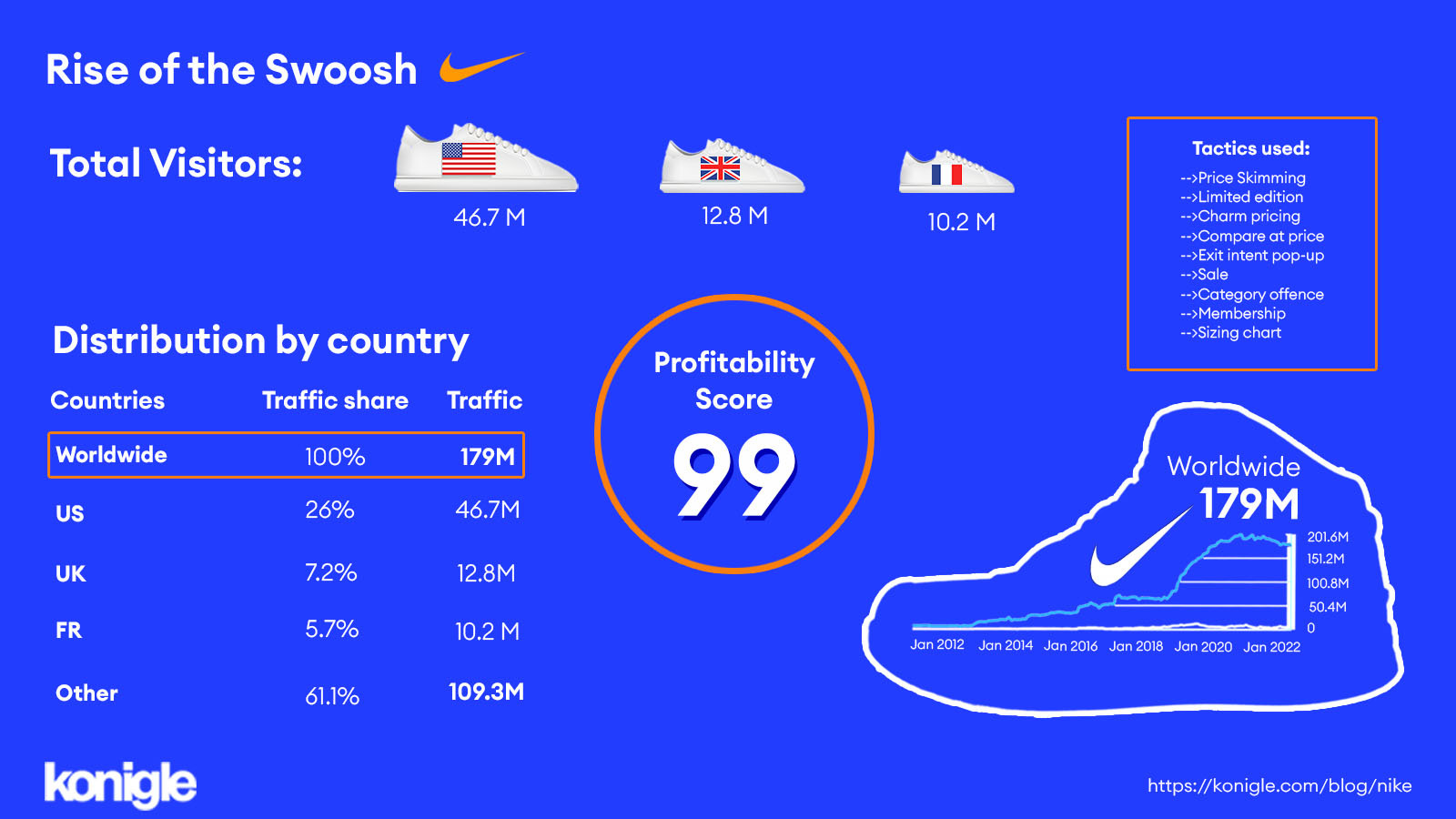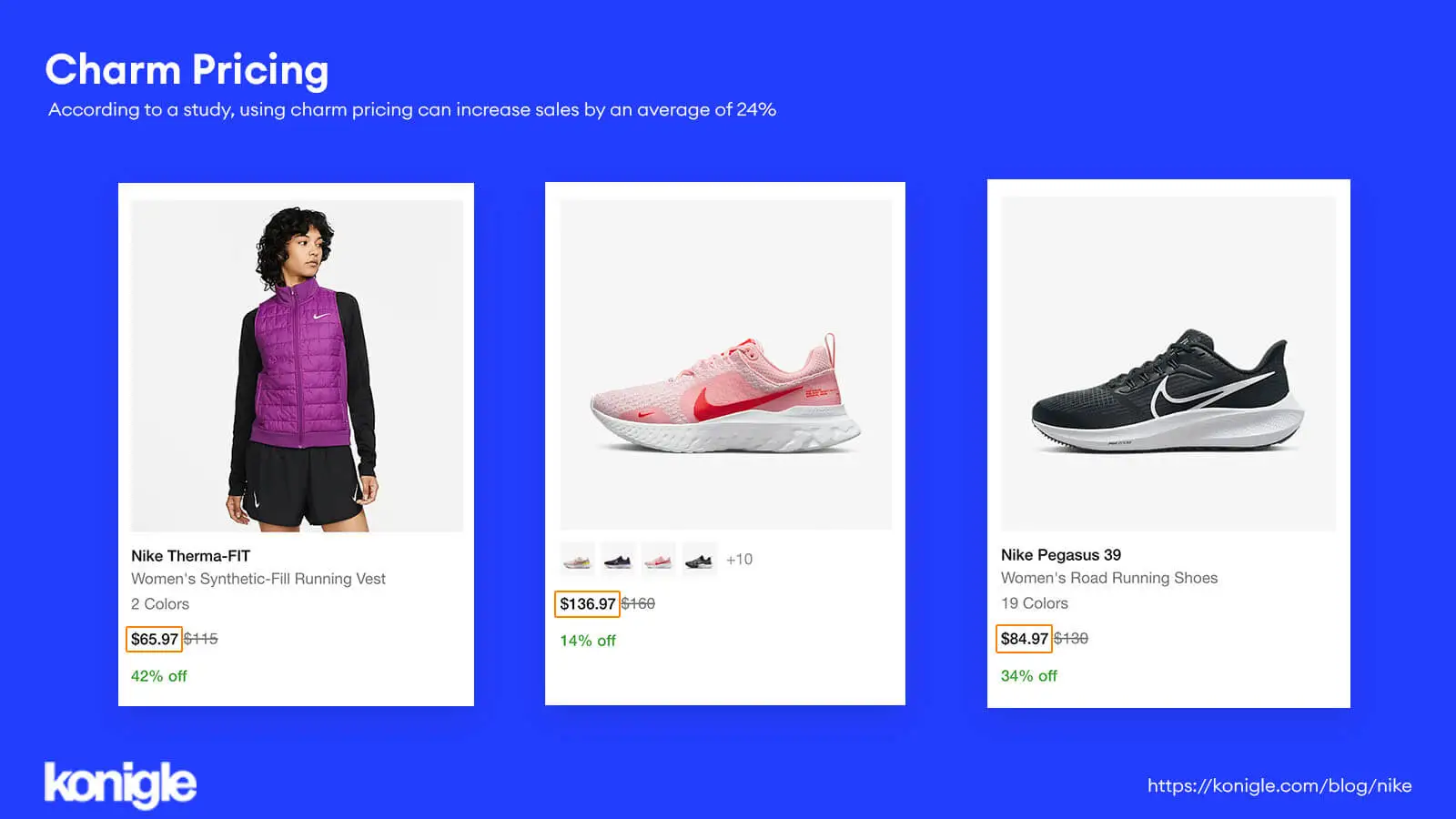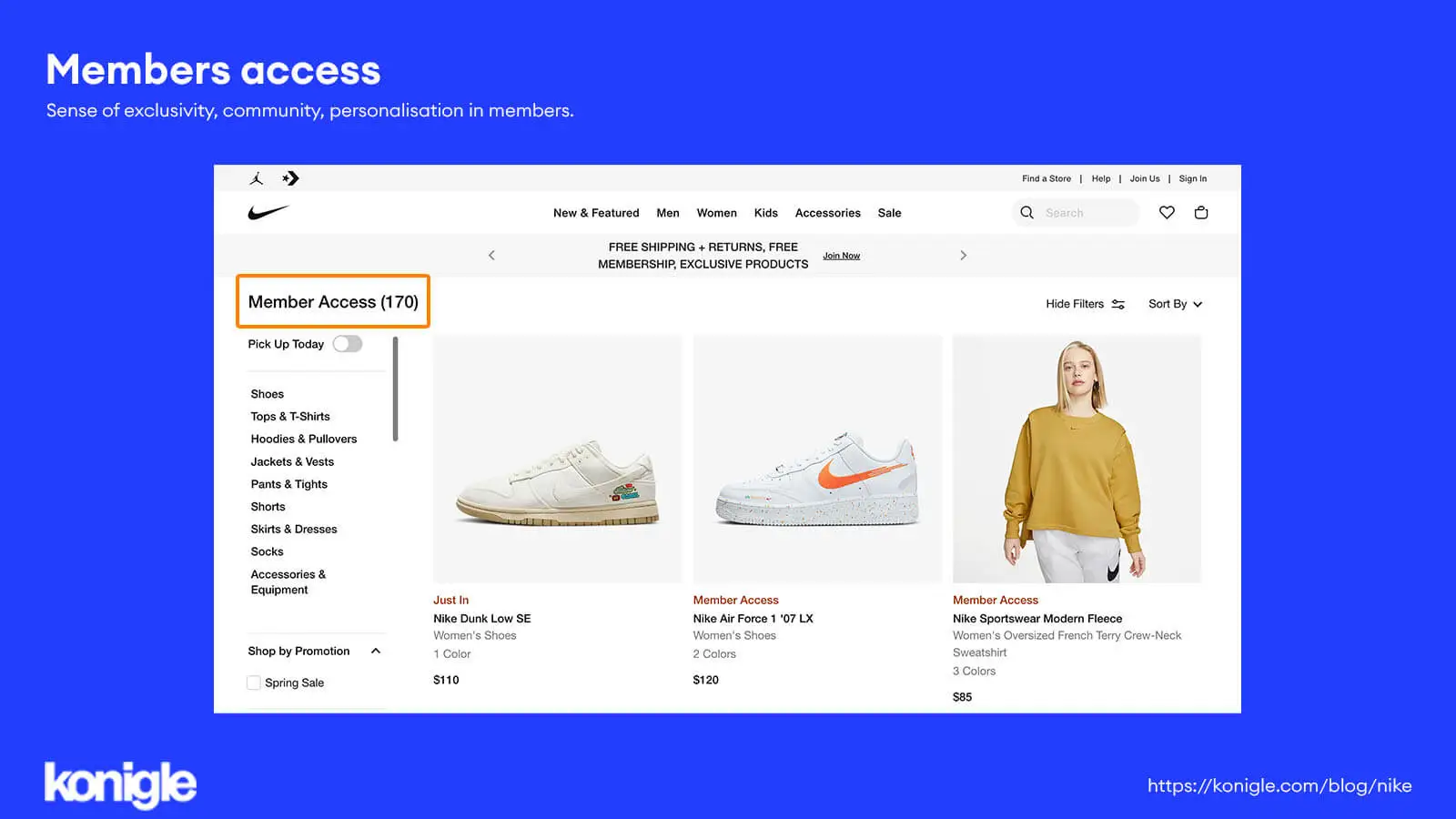November 17, 2024
Nike: Ecommerce Case Study
From the iconic swoosh logo to the ‘Just Do It’ slogan, Nike has become one of the most recognisable brands in the world. Here are 7 + 2 tactics to steal from nike.com and implement on your online store.
In the spotlight this week, we have Nike, Inc, an American multinational corporation that designs, develops, manufactures, and markets apparel, footwear, accessories, equipment, and services worldwide. Founded in 1964 as Blue Ribbon Sports, the company became Nike in 1971 after the Greek goddess of victory.
So, why did Nike become so successful? Here are 9 things we have identified that business owners can learn from them in this Nike case study:
1. Price skimming by Nike
Price skimming is a pricing strategy where you initially charge the highest price that your market will accept for your product and then lower it over time. The logic behind this strategy is that you attempt to "skim" off the top market segment to which you appeal (aka early adopters) at the time when your product is freshest, thereby maximising your profit margins early on. Then dropping prices after that to attract more price-sensitive consumers.
Nike applies a price-skimming strategy whenever it produces new products. By implementing this strategy, Nike tries to skim money from the customers who want the product and are willing to purchase it at that price. After a newly designed product has been out in the market for a while, Nike lowers the price of those products. Normally, Nike shoes are sold at peak prices for a period of 3 to 6 months, and after that period, there comes an activity called closeout, where prices are reduced gradually.
An example of this pricing strategy can be seen with the release of the Nike Air Force 1 shoes. When these shoes are first released, they are selling at $130. However, after the initial demand for the shoes decreased, Nike lowers the price to $110. This strategy allows Nike to still make a profit on its products, even when the demand has decreased.
This can be easily done with Konigle's Bulk Price Editor tool:
- Simply set the selling price of the product to the “After Launch Price” and the validity period to begin after launch period.
- Then make another pricing request and set selling price to “Before Launch Price” and ensure that valid to date is set as the end date of the launch period.
2. Limited Edition + "New & Upcoming Drops"
Nike creates scarcity and a sense of FOMO (Fear of missing out) with this “Limited Edition” + "New & Upcoming Drops” tactic. They pre-launch limited quantities of sneakers, which induces anticipation and buzz along with FOMO in consumers resulting in a boost in Nike's sales every time.
You can inform your subscribers of an upcoming launch with the Konigle's Bulk Price Editor tool by scheduling draft products to become active at a designated time then creating email + sms campaigns reach out to them.
3. Charm Pricing
Charm pricing is a pricing strategy that involves setting product prices that end in an odd number, such as five, seven, or nine. According to a study, using charm pricing can increase sales by an average of 4% compared to using "rounded" price points.
Nike chooses to round all their products on sale to end with .97. As you can see in the product listings above, the Nike Invincible 2 is priced at $104.97 and the Jordan All-Star Weekend BC is priced at $41.97. This way, buyers will view the products to cost $104 and $41 respectively, perceiving them to cost lesser than they actually do and be more willing to buy.
Want to implement Charm Pricing on your Shopify Store? Use Konigle's Charm Pricing Seller Tool and enable charm pricing on your store within 5 minutes.
4. Compare at price
On online stores, compare at price is the product’s original price that shows up on a product's listing when its on sale. Customers will see it crossed out next to its discounted price. This is an attractive way to help customers see the gap between the price now and then and how much they would be saving.
5. Exit Intent Pop ups
Exit intent pop ups can come across as annoying if not done well. But when they’re used at the right time, exit intent popups are an effective strategy for increasing revenue. These popups when used simultaneously with discount codes can boost conversions, reduce cart abandonment and bounce rates, and increase sales.
Here's how nike.com has implemented the exit intent pop-up on their website.
You can notice here how they wait for a certain time for a visitor to browse their website before showing an exit intent pop up. There are only three things to fill out, and they’ve limited your choices so you can complete the form fast.
6. Seasonal sale + Promotional details
Nike has a dedicated Sales collection page on their website. This quickly highlights products being sold at a discount for bargain buyers. This is a good way to boost sales from people looking for an easy way to get discounted apparels.
They also have promotional descriptions added to each products on sale. This enables shoppers to know of other existing promotion and end up spending more.
If you would like to implement this on your Shopify Store, you can use Konigle's Bulk Price Editor tool to:
- Add tags on discounted products as you edit prices and show them on the Sales Collection Page.
- Add promotional descriptions before submitting price change requests
7. "Category Offense" by Nike
In 2008, Nike reorganized based on sports rather than products (e.g., soccer, softball, volleyball) in an approach known as “category offense”. The aim was not to create better shoes or apparel at first, but rather to identify what athletes are trying to achieve and where they face difficulties. Only after discovering athletes’ unmet needs does Nike attempt to apply its technical expertise to create new and improved offerings. This shift to focus on sports and athletes rather than product categories has led to massive sales growth with high pricing power; people aren’t just buying shoes but a tool to get a job done, hence willing to pay a premium price.
Moreover, once a shoe works for a sport that the the customer plays, the customer is more likely to buy more from Nike, increasing customer life time value.
Every company should implement a “Category Offense”. To do so effectively, you must discover what jobs your customers are trying to get done and how they measure success. That’s how big winners like Nike “just do it,” and you can, too!
8. Exclusive memberships
The Nike membership program is a club where Nike customers and fans can receive exclusive perks. There are many benefits of the Nike loyalty scheme such as exclusive products, early access to product launches, special offers on birthdays and, to top it off, free delivery.
This is a successful loyalty strategy that many stores should learn as it creates a sense of exclusivity, community, personalisation in members. All these contributes and strengthens brand loyalty.
Wondering how you can steal this loyalty strategy? Do so by rewarding your loyal customers when you create customer based price rules with Konigle's Customer Based Pricing tool!
9. Sizing chart
Shopping online may be convenient, but it poses a challenge when it comes to choosing the right size. Since customers cannot physically touch or try on items, eCommerce businesses face a high average return rate of 20–30%, with 60% of returns attributed to fitting / quality issues. In other words, these companies lose a significant amount of money due to customers returning their orders. To reduce chances of a return, a size recommendation chart becomes a must-have.
With an elaborate sizing chart for all their products, this gives customers more trust in Nike's product as they will have a better idea of how the apparels will look like on themselves and hence more willing to purchase. This is a way to both reduce return requests and increase AOV. In addition, the elaborate sizing chart they provide caters to an international audience hence widening their customer base greatly.











